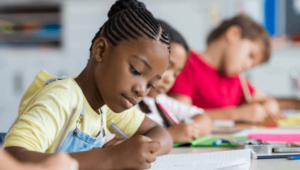Three Toolkits To Help Maximize Student Learning & Engagement

By Gillian Judson, PhD
Emotion.
Imagination.
Feeling.
These words rarely take center stage in curriculum talk.
The odd thing is that I have never met an educator that doesn’t value emotional and imaginative engagement. All educators want students to be engaged. All educators want their students to be imaginative, to experience and demonstrate creative and flexible understanding of knowledge. All educators want students to remember what they are learning so that curriculum content has an impact on their lives outside school.
Finding Common Ground: The Heart of Learning
Sure, the students in our classes are incredibly diverse. The contexts we teach in and the demands of our various curricula are incredibly varied. But all educators stand on common ground.
Educators of all kinds and in all contexts are in the business of meaning-making. And, at the end of the (school)day, meaning requires emotion. As Dr. Immordino-Yang shows us in her research in affective neuroscience—and what I think all teachers know deeply—is that emotion is the mind’s rudder. Emotion directs all learning.
Imaginative Education: An Emotion-Focused Pedagogy
Our students frequently and routinely think about the world in ways that evoke their emotions and imaginations. For example, they universally enjoy stories or narratives of all kinds. They all enjoy jokes and humor. They all identify patterns in the world around them. Many are fascinated by extremes of experience and limits of reality–the stuff in the Guinness Book of World Records. Many associate with heroes and even idolize people, ideas or institutions. Many start collecting things and obsess over hobbies.
Words cause images to arise in all of their minds. They all enjoy a good mystery and can be left awestruck by unanswered questions or strange events. Our older students may enjoy abstract ideas and theories that represent them. Some seek ways to enact change in their environments. I could go on and on; our students’ emotional and imaginative lives manifest themselves in many varied ways.
These different forms of engagement are not insignificant; they are actually ways of thinking that help human beings learn. In Imaginative Education, a pedagogy developed by Dr. Kieran Egan from Simon Fraser University, these features of our imaginative lives are “cognitive tools“–they are emotional ways human beings make meaning in the world.
Dr. Kieran Egan’s theory of Imaginative Education offers all educators a glimpse into the imaginative and emotional lives of their students. He outlines the particular sets of tools students are using to make emotional sense of the world and how any teacher can use these same tools to shape curriculum.
Take this home: You can nurture the heart of learning—engaging emotion with your curriculum content—if you know what cognitive tools your students employ and if you use them in your teaching.
Three Toolkits To Maximize Student Learning & Engagement
1. The Toolkit of Oral Language: story-form, dramatic oppositions, vivid mental imagery, rhyme, rhythm & pattern, a sense of mystery, play.
These tools will be most active for our youngest students, those who engage with the world mostly through their bodies and through oral language. The richness of meaning offered by the tools of oral language is well-known. For generations, these tools have made knowledge meaningful and memorable in an oral context.
The same is true for human minds equipped with oral language today. Of course, all ages of students will be engaged by these tools. It is always worthwhile employing them in your teaching, so use imagery. Identify patterns. Notice the mysterious. Play.
2. The Toolkit of Written Language: story-form/narrative, heroic qualities, humanization of meaning, extremes of experience and limits of reality, a sense of wonder, games/play, visual manipulation of information, rebellion, collections & hobbies.
We aren’t aware of it at the time, but learning to read radically changes our perception of the world. If you observe kids as they learn to read, you may notice the shape of their imaginative interest changes—according to Dr. Kieran Egan this is due, in part, to a need to make sense of a new and vast reality.
Once we are literate, different features of the world attract our attention—or, in other words, we want to know about different aspects of knowledge. One thing hasn’t changed; knowledge that makes us feel a human emotion is knowledge we remember. You can feed your students’ need for heroes within your curriculum. You can include the human story. You can illuminate the unique, odd, exotic and bizarre.
3. The Toolkit of Theoretical Language: meta-narrative structuring, general theories, anomalies, sense of agency.
Students who are supported in thinking about abstract ideas and questions often realize that the world at our fingertips also exists in a completely separate, theoretical realm. This is immensely appealing to theoretical minds. The world of theory and abstraction attracts the imagination differently.
So, for those educators working with older students/adults, one can and should employ tools of oral and written language in teaching, but it is also very important to feed the theoretical aspects of the mind. What’s the “Truth” on this topic? What “ism” explains its different dimensions? How can students’ participate in the topic in a real-world way?
That Was Quick
Too soon for a conclusion, I know. We have barely scratched the surface! My hope is that you are curious to learn more about how to meet the imaginative needs of your students and, ultimately, maximize their imaginative capacities. You can explore the whole set of “Tips for Imaginative Educators” in this Tools of Imagination Series. Use the right tools and you will bring emotion, imagination and feeling out of the wings and onto center stage.
For more, see:
- The Danger of Designing Lessons for Thinkers
- 9 Ideas for Combatting Boredom in School (and Why Being Bored May Not Be All Bad)
- Smart Review | Make, Learn, Succeed: Building a Culture of Creativity in Your School
Gillian Judson is a researcher, teacher and advocate of the role of imagination in all learning. Follow her on Twitter: @perfinker.




Pius Taman
Imagination emerges from leadership view especially knowing the heart wow this is real. Learning is to do with cognitive intelligence which is through education nation. However, knowing is emotional which comprises in-built traits, skills, talents, instincts naturally. I therefore, totally agree with the concept of imagination or day dreams as Les Brown puts it "dreams are the children of the soul, the blue-prints of the ultimate achievements." I believe in the power of imagination.